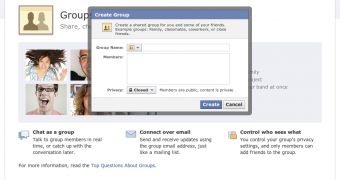Facebook anticipated announcement came and, despite all the speculation and guesswork, it was something completely new and something no one even came close to predicting. The big announcement was a completely revamped Groups feature that doesn't really have anything to do with the old one.
Just like most other big players in the social space figured out, Facebook realized that one of the biggest problems with social networks today was the impossibility to separate your friends from your family from your colleagues.
There are plenty of things you don't want your family or your boss to see and plenty of things that wouldn't interest most of your friends. Facebook has had Lists for quite a while to enable users to group their friends, but only 5 percent used the feature and it proved ineffective.
Facebook says that approaches to doing this so far have failed for a number of reasons and are flawed in their design.
Asking people to group their friends manually and then create privacy settings for all the lists, like Facebook has had, doesn't work because it's too much hassle. Google has done something somewhat similar recently with Orkut groups.
Similarly, doing it algorithmically, like Google tried with Buzz, has its many flaws as well, as Google found out the hard way.
The new 'social' Groups
So Facebook has opted for a 'social' solution. It used the one seemingly small feature that made the photos section so popular, tagging, and used it to enable users to easily create new private spaces just for the friends they want.
The new Groups feature is actually quite straightforward. You can create a group for your family, for your soccer team, or for whatever group of friends, and add the ones that you feel should belong there.
You can create a Public group, a Closed one, the default setting where all of the actions and content stays private but the members are public, and a Secret one.
After this, everything you do in a group stays in a group, depending on your privacy settings, only the ones in the group will see the photos, posts, links and so on, that members will share.
A number of tools also come in handy like the group chat or the collaborative 'doc' tab.
A crucial feature is that, by default, members can tag others to add them to the group, essentially enabling social circles to form naturally. The feature itself is simple and it's based on existing concepts and features.
But the way Facebook put it together and little details show why Facebook has steamrolled over its competitors the social space to go on to get 500 million users and why no one, not Google, not Twitter, has any chance of getting close any time soon.

 14 DAY TRIAL //
14 DAY TRIAL //